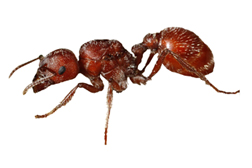Testing the actuation of the polymer film. Materials and electronics: VHB polymer film, conductive graphite powder, acrylic glass, high voltage converter, variable power supply, cables.
Pages
Categories
Archives
Final Thesis
Testing the actuation of the polymer film. Materials and electronics: VHB polymer film, conductive graphite powder, acrylic glass, high voltage converter, variable power supply, cables.

Testing the elasticity of VHB polymer film membranes attached to the planar surface. This method could be applied to the system of polymer actuators inside the final object prototype.


Read More
By applying the attraction-repulsion code from the Nature of Code publication by Daniel Shiffman, I try to simulate the possible behavior of the fire ant colony when exposed to the electric fields. Six attractors represent six capacitors forming the electric field. When voltage is applied, electric field of each capacitor starts to attract the ants. Different voltage loads applied to the capacitors cause the swarm of ants instinctively choose the strongest source at the time. When capacitors are off the ants dissipate rapidly.

Ant image: Alexander Wild
There is an interesting phenomenon in the nature. Certain species of ants are attracted to the electric fields created by the high voltage devices. They tend to build nests close to the high voltage switch boxes, invade the electrical equipment, short out electronic gadgets, cut through the metal wires. No one really knows why. Research studies have been done on this phenomenon. Some claim this happens because particular species of ants are capable of detecting electromagnetic fields and may even use the Earth’s magnetic field as a directional cue as they search for food and nest locations. Their attraction to the man-made electrical devices may be an accidental evolutionary byproduct of this natural ability.
Their behavior is still incomprehensible to us. We perceive them as a threat which would invade our homes, build the nests in our electrical devices and cause a damage. My idea is quite the opposite. What if these ants were the users to design for? What kind of habitats whey would like to inhabit? Would I be able to design an environment in which they would enjoy their attraction to the electrical fields without causing any damage and harming one another? I think of an object which would contain this micro environment, providing food, nest and also an object which could create the electrical field in which they could interact. An object which could also form a sensory communication with the ant colony, could react to they presence and based on that it could provide the amount of electricity. Read More

Could the phantom electricity load provide enough power to actuate the system of polymer actuators? Can this system become a parasitic consumer of the phantom electricity and can its behavior reflect the intensity of the leaking electricity?
Phantom load, or leaking electricity (“phantom load” and “leaking electricity” are defined technical terms with other meanings, adopted for this different purpose), refers to the electric power consumed by electronic and electrical appliances while they are switched off (but are designed to draw some power) or in a standbymode. This only occurs because some devices claimed to be “switched off” on the electronic interface, but are in a different state from switching off from the plug, or disconnecting from the plug, which can solve the problem of standby power completely. In fact, switching off at the plug is effective enough, there is no need to disconnect all devices from the plug. Some such devices offer remote controls and digital clock features to the user, while other devices, such as power adapters for disconnected electronic devices, consume power without offering any features (sometimes called no-load power). All of the above examples, such as the remote control, digital clock functions and, in the case of adapters, no-load power, are switched off just by switching off at the plug.